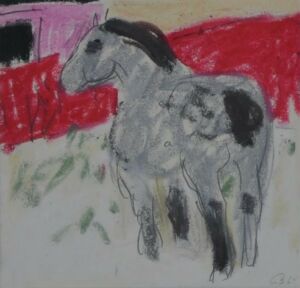February 1, 2023

“Dapple Gray” 1964, Cameron Booth
When I catalogued Dapple Gray, I knew it was one of my favorites from the collection. Part of it was the bold red fence, the size of the work (only a couple inches tall) and how thick the horse is. This horse is the definition of “tall, dark, and handsome.”
Why does Hennepin History Museum have such a delightful drawing in its collection? Well, the artist is Cameron Booth (1892-1980), the renowned “Dean of Minnesota Artists.” He was dubbed so because of his long teaching career in the Minneapolis School of Art, the St. Paul Gallery and School of Art, and the University of Minnesota. This doesn’t even include the work he did at the Art Students’ League of New York or the University of California at Berkeley. But before he was a teacher, Booth was a student. And before that, he was a child drawing what he saw in his daily life.
Booth was born in Erie, Pennsylvania. His family moved around to several states when Booth was a child. In Iowa, when Booth was twelve, he owned his first horse. In South Dakota, the family owned a workhorse, which Booth cared for. Eventually, the family settled in Moorhead, Minnesota, where Booth attended high school. After graduating in 1912, Booth went to the School of the Art Institute of Chicago. This exposed him to modern art styles, namely Impressionism.
Booth did well academically and earned a travelling fellowship by the Institute in 1917. He used the money to travel to France. After serving in World War I, he returned to France for a couple of years, continuing his art education. Then in 1921, Booth accepted a faculty position at the Minneapolis School of Art, now the Minneapolis College of Art and Design. Thus began his teaching career.
Around the same time, Booth began entering his works into competitions and exhibits. Horses remained a common theme among his work. In 1922, Booth’s Horses and Men won first place at the Minnesota State Fair. One of his most famous works, Horses, was exhibited in the 120th annual exhibition at the Pennsylvania Academy of Fine Arts. It then became the first of Booth’s paintings to enter a museum collection. According to Booth, it was a horse-centered work that President Coolidge had in his own private collection.
Booth became a well-known abstract expressionist. His work underwent several evolutions, and in the 1950s, it veered far more to the abstract. The next decade, however, was dubbed his “neo-horse period” by John K. Sherman, a Minnesota art critic. Booth had several one-man art shows where the works featured horses or barnyard scenes. Sherman noted that in these works “man is absent…equine equanimity takes over.”
It is a 1964 show that relates to this specific work, Dapple Gray. The show took place at the Bottega Gallery and included twenty paintings and over one hundred colored crayon drawings. Booth explained that the drawings were the first part of his creative process. He started with color, giving shape to budding ideas. He then used the crayon designs as a jumping off point for paintings, though he didn’t always stick with the same design. Dapple Gray would have been used in this way and was likely one of the hundred designs displayed in 1964.
In a 1926 newspaper interview, Booth recounted his early days of artistry. “…I don’t remember the first picture I ever drew, but no doubt it was a horse.” Regardless of what his first drawing was, we cannot deny that Booth had a great impact on the Minnesota art scene. And he drew and painted horses every step of the way.
Author Bio: Written by Summer Erickson, former Visitor Services Manager and Collections Assistant at Hennepin History Museum. Erickson graduated with a B.A. in Art History and Museum Studies from the University of St. Thomas in 2020. They cataloged HHM’s art collection in 2021. Erickson is currently working as a receptionist for MSS.
Bibliography
Archabal, Nina Marchetti. “In Memoriam: Cameron Booth 1892-1980.” Minnesota History. Minnesota
Historical Society: Fall 1980.
http://collections.mnhs.org/MNHistoryMagazine/articles/47/v47i03p100-110.pdf
“Booth, Art Student, Doubled as Waiter.” The Minneapolis Star. Jan. 15, 1926.
https://www.newspapers.com/clip/90190501/
“Cameron Booth.” Gallery5004. Accessed Dec. 07, 2021. https://www.gallery5004.com/cameron-booth
Frost, Rosamund. “Minneapolis’ Artist Cameron Booth Paints the ‘Real’ West with Integrity.”
Star Tribune. Jan. 07, 1944. https://www.newspapers.com/clip/38874651/mortimer-brandt/
Sherman, John K. “Booth Art Shows ‘Earthy Poetry.” Star Tribune. March 10, 1963.
https://www.newspapers.com/clip/90190781/
Sherman, John K. “Cameron Booth’s One-Man Show.” Star Tribune. June 21, 1964.
https://www.newspapers.com/clip/90195567/
Sherman, John K. “Top Rank Abstractionist Combines Horses and Art.” Star Tribune. June 14, 1964.
https://www.newspapers.com/clip/90195417/
Sherman, John K. “Visionary Artisans Leap Beyond Art’s Traditional Limits.” Star Tribune. March 12,
 This blog was made possible in part by the people of Minnesota through a grant funded by an appropriation to the Minnesota Historical Society from the Minnesota Arts and Cultural Heritage Fund. Any views, findings, opinions, conclusions or recommendations expressed in this publication are those of the authors and do not necessarily represent those of the State of Minnesota, the Minnesota Historical Society, or the Minnesota Historic Resources Advisory Committee.
This blog was made possible in part by the people of Minnesota through a grant funded by an appropriation to the Minnesota Historical Society from the Minnesota Arts and Cultural Heritage Fund. Any views, findings, opinions, conclusions or recommendations expressed in this publication are those of the authors and do not necessarily represent those of the State of Minnesota, the Minnesota Historical Society, or the Minnesota Historic Resources Advisory Committee.
